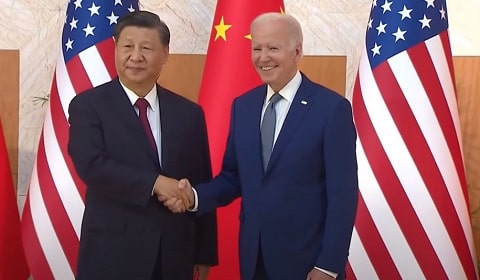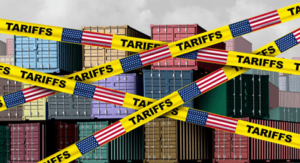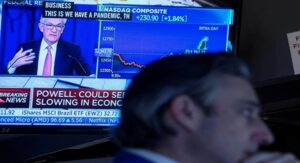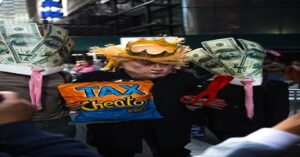
The Irony of American-Chinese Economic Relations
American-Chinese economic relations encapsulate a complex interplay of contrasting ideologies and converging interests, shaping the global economic perspective. While conventional wisdom often attributes tensions between the United States and China to their divergent political and economic systems, a closer examination reveals a nuanced relationship defined by shared strategies and mutual dependencies.
Despite ideological disparities—capitalist democracy versus state-driven governance—both nations have pursued economic policies aimed at bolstering domestic industries and national security. China’s strategic interventions in its economy, characterized by targeted subsidies and protective measures, have reshaped global trade dynamics, fostering both admiration and criticism.
Conversely, recent shifts in U.S. economic strategy under administrations like Trump and Biden mirror aspects of China’s industrial policies, signaling a convergence in approaches. Amidst these complexities, transparent communication and targeted policy measures hold the key to navigating challenges and fostering constructive engagement between these economic giants.
Table of Contents
American-Chinese Economic Relations
The economic dynamic between the US and China is commonly framed as an ideological battle: US capitalism versus China’s state control. Yet, a nuanced examination uncovers a paradoxical alignment of strategies despite surface disparities.
Both nations intertwine through trade, investment, and technological exchange, blurring ideological boundaries. Economic interdependence fosters cooperation and competition simultaneously in American-Chinese economic relations. Each side strategically navigates this complex relationship, leveraging strengths and exploiting vulnerabilities.
This convergence amidst apparent divergence underscores the intricacies of modern geopolitics, where economic interests transcend ideological differences, shaping a scenery of mutual dependency and strategic maneuvering.
This article delves into the complexities of American-Chinese economic relations, highlighting key strategies and their implications.
1. Divergent Paths, Converging Goals
Despite stark ideological disparities, both nations share a common pursuit of economic rejuvenation and resilience. The US, grappling with relative decline, increasingly adopts strategies reminiscent of China’s focus on national economic strength, which is intertwined with American-Chinese economic relations.
This shift underscores a convergence in objectives, albeit through different means. According to the International Monetary Fund (IMF), China’s GDP grew by an average of 9.6% annually from 1978 to 2018, propelling it to become the world’s second-largest economy.
Meanwhile, the US remains the largest economy globally, but its annual GDP growth averaged around 2.3% during the same period, highlighting its relative stagnation. This divergence in growth rates suggests a recalibration of global economic dynamics and a potential reordering of power structures.
2. China’s Strategic Play
China’s economic policies and politics transcend mere growth, aiming for global prominence. Employing a “window with a screen” approach, China harnesses globalization while safeguarding its industries. This strategy fuels its swift ascent and alters global economic dynamics.
Trade volume soared from $20.6 billion in 1978 to $4.6 trillion in 2019, highlighting China’s integration into the global economy. Additionally, its share of global exports surged from 1.8% in 1980 to 14.7% in 2019, cementing its pivotal role in international trade.
American-Chinese economic relations have played a significant role in this trajectory. China’s economic agenda extends beyond prosperity, aligning with a national vision of reclaiming global stature, strategically maneuvering within the currents of globalization to shape its trajectory.
3. The Rise of “Chinamerica”
Historically, Western and Chinese economic models displayed a symbiotic relationship, yet tensions emerged over time. American-Chinese economic relations, characterized by trade agreements and investment ventures, have played a significant role in shaping this dynamic.
Western manufacturing sectors saw declines, prompting a reevaluation of economic strategies. Populist sentiments surged, indicating a pivotal moment in economic discourse. The Economic Policy Institute reports a loss of 3.7 million US jobs, notably in manufacturing, due to heightened Chinese imports from 2001 to 2018.
This trend exacerbated income inequality and bolstered anti-globalization sentiments. The interplay between Western and Chinese economies, once seen as complementary, now underscores complex dynamics shaping global trade and socio-economic aspect.
Reassessing policies becomes imperative in navigating these challenges and fostering equitable growth in both regions.
4. A New American Strategy
In a departure from market fundamentalism, successive US administrations have embraced industrial policies mirroring China’s approach. Prioritizing domestic resilience, green investment, and supply-chain security, this shift aims to safeguard national interests and foster societal unity.
The Biden administration’s proposed $2.25 trillion infrastructure plan underscores this strategy, earmarking funds for infrastructure development, renewable energy projects, and research and development. This concerted effort seeks to rejuvenate domestic industries, spur innovation, and propel sustainable economic growth.
Such initiatives mark a significant recalibration in economic strategy, emphasizing the importance of strategic investment and proactive government intervention in shaping the country’s economic trajectory towards resilience and prosperity.
Furthermore, these developments underscore the evolving view of American-Chinese economic relations, where mutual learning and policy convergence are increasingly evident.
5. Recognizing Parallels, Acknowledging Irony
Despite mutual criticisms, China and the US exhibit similarities in economic approaches, including their respective relationships with state intervention and economic policies. China’s cautious openness mirrors America’s protected prosperity, highlighting irony in their accusations.
Recognizing these parallels is crucial for fostering transparent dialogue, including addressing complexities in American-Chinese economic relations. The World Bank notes both nations rank among the top ten globally in terms of government’s share of GDP, showcasing significant state intervention in their economies.
This shared trait underscores the need for understanding amidst criticism and offers a basis for constructive engagement. Embracing these similarities could pave the way for mutually beneficial cooperation and exchange, promoting stability and prosperity on a global scale.
6. The Imperative of Transparency and Communication
In our globalized economy, transparency and effective communication are essential, particularly in fostering healthy American-Chinese economic relations. Nations must approach policy decisions with empathy, considering the unintended impacts they may have.
It’s crucial to differentiate between constructive industrial policies and harmful protectionism to encourage collaboration amidst diversity. According to the World Trade Organization, the prevalence of trade disputes between the US and China from 2000 to 2020 underscores the urgency for better communication and conflict resolution methods.
By fostering understanding and cooperation, we can mitigate tensions and cultivate a more harmonious international trade environment, ensuring mutual benefit and sustainable development for all stakeholders involved.
7. Balancing National Security Concerns
Ensuring national security is crucial, yet it necessitates a delicate equilibrium with global interconnectedness. The US’s export controls, while ostensibly aimed at security, prompt scrutiny regarding their breadth and repercussions.
It’s imperative for nations to prevent security measures from morphing into covert protectionism, which could sow distrust and escalate tensions. American-Chinese economic relations play a significant role in this delicate balance, given the interdependency of the two largest economies.
The United Nations Conference on Trade and Development underscores the surge in non-tariff measures like export controls, which now permeate global trade, posing obstacles to economic collaboration and stability.
Achieving a balance between safeguarding sovereignty and fostering international cooperation is essential for navigating the intricate outlook of modern security and trade dynamics.
Bottom Line
The irony of American-Chinese economic relations lies in the convergence of strategies amid apparent divergence. While cooperation may remain elusive, acknowledging shared goals and concerns can pave the way for a more constructive relationship.
Transparency, communication, and a balanced approach to security are essential for navigating the complexities of this critical global dynamic. As the world watches the interplay between these economic giants, the path forward lies in recognizing the irony and forging a new narrative of cooperation amid competition.





